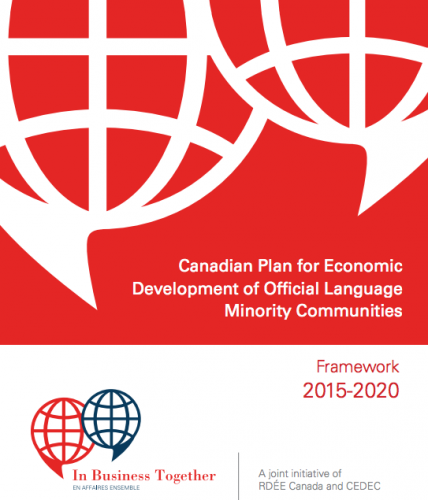EXECUTIVE SUMMARY
The Réseau de développement économique et d’employabilité du Canada (RDÉE Canada) and the Community Economic Development and Employability Corporation (CEDEC) are proud to present the framework for the first 2015-2020 Canadian Plan for Economic Development of Official Language Minority Communities (CPED). This framework outlines the objectives, priority orientations, and the important steps that RDÉE Canada and CEDEC, in collaboration with their networks and partners, need to take over the next five years to promote the employability, entrepreneurial leadership, and economic development of official language minority communities (OLMCs).
INTRODUCTION
The framework represents the conceptual and strategic foundation on which the CPED is based. It provides the basis for defining the objectives and priority orientations that will help determine the future roles of RDÉE Canada and CEDEC, with the aim of promoting the economic development of OLMCs over the next five years. It also serves as a consensus-building tool, rallying the many economic stakeholders to work together on key business challenges facing OLMCs.
The drivers for developing this framework are threefold: the need to spur more effective government action in local economic development, the strategic need for stakeholders to be able to collectively identify the priority orientations that will chart the road ahead for RDÉE Canada, CEDEC, and their partners, and, finally, the need to establish a harmonized governance model to simplify the reporting process.
This framework was developed following a consultation and discussion, during which a comprehensive analysis of the current situation of OLMCs was performed. To support this effort, RDÉE Canada and CEDEC retained the services of PGF Consultants to conduct a national survey among 1,064 respondents (took place in 2014). These respondents, who stemmed from across the country, represented the business community (32%), economic and community development organizations (30%), citizens (20%), educational and research institutions (8%), and government
organizations (10%). This study clearly highlights the mobilization of local, regional, and national partners, and their willingness to work together to enhance the communities’ vitality and economic sustainability. The results of the national survey and the situation analysis will be presented in the document entitled Portrait of the economic development of official language minority communities (see: www.inbusinesstogether.ca)
This extensive consultation allowed us to make key findings from which a consensus emerged regarding the need to spur economic development in official language minority communities.
Download the report
TABLE OF CONTENTS
- MESSAGE FROM THE PRESIDENT OF RDÉE CANADA
- MESSAGE FROM THE PRESIDENT OF CEDEC
- EXECUTIVE SUMMARY
- INTRODUCTION
- BACKGROUND
- MAIN FINDINGS
- Bilingualism of OLMCs: a strategic asset for the Canadian economy
- An evolving socio-economic profile
- PERSPECTIVES
- VISION, OBJECTIVES, AND ORIENTATIONS
- Vision
- Objectives
- Priority orientations
- IMPLEMENTATION
- Strategies
- Governance
- Performance measurement framework
- CONCLUSION
- BIBLIOGRAPHY
- LIST OF TABLES





